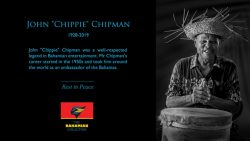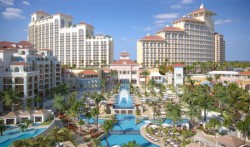BY PETER ZAREMBA
Swimming with the Fishes: Aquatic wonders await divers and snorkelers in the Bahamas.
Mention the Bahamas, and Americans usually think of tourist-packed Nassau or Freeport. But the Bahamas are actually a chain of more than 700 islands (as well as about 2,400 assorted islets and rocks), starting only 48 miles off Miami and stretching almost to Haiti. These are the Bahamas’ “Out Islands,” so called because until fairly recently, they could be reached only by boat from Nassau, the capital.
Over the years, the islands have been quietly attracting boaters, sportfishermen and sophisticated travelers, the key word being “quietly.” Sparsely populated and unspoiled, they’re where the Bahamians continue their traditionally unhurried existence. This adds up to a world of sunshine, empty beaches and crystal-clear waters, minus the crowds or hustlers who plague so much of the Caribbean. Today, the Out Islands increasingly are served by major airlines (Continental, American, USAir) directly from the U.S., as well as by Bahamasair.
Hopping over to Bimini, a 7-mile-long island only 50 miles east of the South Florida coast, is a blast in itself. Just 20 minutes after leaving Florida, the Grumman Mallard “flying boat” operated by Chalk’s Ocean Airways, the world’s oldest scheduled airline, cruises over a broad lagoon that is an ideal harbor for pleasure craft and serves as our landing strip as well. Traffic on Bimini’s main road ラ consisting mostly of golf carts ラ halts as the Mallard lumbers up out of the harbor and across Queen’s Highway. In decades past, the lure of big-game fishing enticed the likes of Howard Hughes, Adam Clayton Powell Jr., Richard Nixon and even Lucy and Desi Arnaz to this discreet hideaway. But older locals still talk about fisherman (and drinker) Ernest Hemingway, who wrote “To Have and Have Not” in room No. 1 at the Compleat Angler. The Abaco pine walls of this fishing lodge are shellacked with photos of yesterday’s big-game sportfishermen and the ones that didn’t get away. You can stay here, too, or rent the Blue Marlin Cottage, where “Papa” wrote “Islands in the Stream.”
Other than fishing, there’s little that demands doing here besides swimming at one of the deserted beaches and musing over the island’s lore, beginning with Ponce de Leon’s 1512 search for the Fountain of Youth (an attraction of dubious authenticity on South Bimini). The island has no mega-resorts, and half-finished projects are a reminder that laid-back Bimini is an island where grandiose schemes often go awry. Witness the presidential aspirations of former Sen. Gary Hart, which fizzled after his headline-making bongo solo in the bar of the Compleat Angler during a covert expedition with paramour Donna Rice.
I’d have loved to spend an evening there, or at Adam Clayton Powell’s old hangout, a sand-strewn shack where you can play dominoes for rounds of Kalik, the Bahamian national beer. But too soon it was off to the next destination.
NEXT STOP, ABACO
With its boomerang shape traced by a string of outlying cays (pronounced “keys”), pine-studded Abaco is the second-largest island in the Bahamas, at a length of 120 miles. Although there are several modest international airports on Abaco, we exercised the option of a water landing and waded ashore on the spectacular 3.5-mile crescent of pale, talc-soft sand at Treasure Cay. Treasure Cay Resort’s 147-slip marina makes it a prime destination for Florida boaters, but the sportfishing in Abaco is none too shabby either. Underscoring the point, a 1,030-pound blue marlin with the dimensions of a small submarine is mounted on a wall of the resort’s restaurant.
Most of the islanders are descendants of Loyalists from the British colonies to the north, who sought refuge here after finding themselves on the losing side of the American Revolution. And they’re no more politically savvy than their ancestors: Abaco unsuccessfully petitioned Britain to remain a colony when the Bahamas were granted independence in 1973.
The Bahamas’ multicolored waters have shaped every aspect of life here, even providing the country’s name, baja mar being Spanish for “shallow sea.” We headed through them to explore the cays aboard the 50-foot cabin cruiser Islander, as the infectious sounds of “Sweet Emily, the Queen of Junkanoo” pumped from the sound system.
“Eighteen Spanish galleons went down right off here. That’s why it’s called Treasure Cay,” yelled Capt. Perry Thomas as he piloted us through the 79.9-degree waters.
Our destination was New Plymouth, a tiny settlement on Green Turtle Cay that is often likened to a New England fishing village. Despite the tidy shingle cottages and picket fences, the Nantucket comparisons only go so far, and the iciest thing in these parts is a cool swig of Kalik.
“My father was a captain and a shipbuilder, too,” began Noel Augustus Roberts, an 89-year-old Loyalist descendant who led us through the Albert Lowe Museum. Roberts vividly described turtle fishing, the selection of trees for boat construction and Abaco’s seafaring traditions, but emotion rose in his voice as he came to photos showing the devastation of the Hurricane of ’32. “It just about wiped out the town…” But he moved on quickly. “Did you see Princess Margaret’s photo?”
Back on the Islander ラ and fortified with rum punch ラ we headed to North Guana Cay for snorkeling. As I floated in 20 feet of gin-clear water over towering pillars of staghorn coral and waving lilac sea fans, the largest mahogany snapper I ever saw cruised nonchalantly past my mask. Unfortunately, I returned to the boat before my companions spotted a 6-foot black-tipped shark.
We then pulled into Great Guana Cay for lunch where the choices were fresh grilled tuna, wahoo or mahimahi. As we headed back to Treasure Cay, First Mate Sam Anderson rhapsodized about Out Island life. “Go beachin’, fishin’, grill it up and have the whole beach to yourself. Yah man!” he sighed.
Two-hundred miles southwest of Abaco lies a peaceful 76-mile sliver of land that shares nothing other than its name with our own Long Island. The white headlands at Cape Santa Maria have changed little since Columbus made his second landfall in the New World here in 1492. The plane circled a beach that seems ラ incredibly ラ even more spectacular than the one at Treasure Cay. Scattered among the palms and wispy pines along the beach’s vast arc are the white cottages of Santa Maria Bay Beach Resort, one of Long Island’s two understated resorts. Snobs may sniff, but we found reef fishing off Cape Santa Maria (on the island’s Caribbean side) with Capt. Humphrey Brown more rewarding than fly-fishing, and in 90 minutes filled a chest-and-a-half with colorful queen triggerfish, snapper and porgy.
The wild, rocky coast of Long Island’s Atlantic side is notched with secluded coves the locals call “love beaches” and unique “rock pools” ラ narrow channels carved by waves and up to 8-feet deep ラ that are popular with snorkelers. Loyalists from Carolina settled here in the late 18th century and built vast plantations, but today only ruins and about 4,000 friendly descendants of their slaves remain.
Stella Maris is the island’s oldest resort, and has been a well-regarded dive center since 1965. Visitors can rent a European expat’s villa or book a room in the main hotel. Doors here are never locked, a legacy of Out Island honesty. (Criminally minded readers take note: Polite constables and Her Majesty’s extremely rudimentary one-room stone prison await wrongdoers here.) Thursday nights, everyone gathers on Stella Maris’ stone patio for a rum-punch party, where the big, outdoor hearth is fired up and platters of seafood and steak are grilled. The abundant punch worked its magic, and as the calypso band launched into “On My Island” for the third time, it seems that everyone had found their “paradise in the southern Bahamas.”
Spectacular specks
The final destination on my Out Islands tour is the Exumas, a chain of 365 tiny cays and islets strung like pearls across 100 miles of sea southeast of Nassau. Great Exuma Island is poised for great development, including a 240-room Four Seasons Resort set to open next year. But for now, things remain as they have for centuries. The excellent harbor at the main settlement of George Town was once infested with murderous pirates. Today, the white walls and blue shutters of St. Andrew’s Anglican Church crown the town’s highest point, as if to exorcise those evil memories. Directly below, on the site of an old slave market, is the Peace and Plenty, a peach-colored colonial-style inn built around a courtyard containing a poolside bar where the bartender is called “Doc” by grateful patrons.
Staniel Cay, population 85, is 55 miles north of Great Exuma. It is the gateway to Exuma Land and Sea Park, and we are there with Ray Darville, sole warden of the park’s 176 square miles, volunteer Bill Hirsch and local personality Donny (Yellowman) Ferguson.
This remote speck of land can be reached from the States by charter flight. Or like Donny, you can take the mailboat from Nassau. It’s an eight-hour trip, but there’s air conditioning and cold beer, Donny notes. We hopped aboard motorboats and headed for the park. First stop, Thunderball Grotto, where 007 battled the minions of arch-villain Largo.
Coral and sunbeams
With the “Thunderball” theme song thundering in my head, I ducked through an almost submerged passage in the rock and bobbed up in a large domed chamber lit by sunbeams piercing through a natural opening in the roof. The sheer variety of tropical fish inhabiting the subterranean waters banished Tom Jones from my mind. Marveling at the underwater gardens of lavender, green and lilac coral, I allowed the current to gently pull me through another tunnel to the opposite side of the cay, where Bill’s boat waited.
Weaving between the countless tiny islands, we raced though passages in the rock barely wide enough for our boat. The sea’s color ranges from a brain-overloading cobalt blue to emerald green streaked with pearly white. We arrived at Warderick Wells, where Darville’s wife and three children live at the fanciful park headquarters, which reminded me of Disney’s Adventureland. You can share their desert isle life in exchange for volunteer work. I was ready to sign up right then and there, but it was time to start heading back to the Peace and Plenty for dinner.
Besides, there’s still Eleuthera with its pink beaches, San Salvador, where Columbus first set foot in the New World, Inagua with its thousands of flamingos, and about 690 other Out Islands left to discover …



